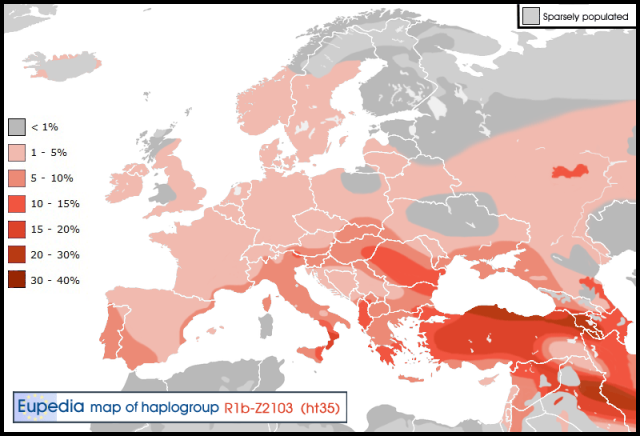Angela,The prehistoric settlement of Castelluccio was built on a rather isolated but defensible rocky spur.The Castelluccian villages, sometimes fortified, showed a rather interesting agricultural and pastoral reality.It makes me think of the construction of La Bastida on a hilltop near Murcia, eastern Iberia some 170 later (2000 BC) and the subsequent El Argar culture.Was the settlement of Castelluccio one of the earliest in Castelluccio culture?
That's precisely what I meant, Bicicleur.
The question is, did they perhaps carry Z2103 and steppe, or J2b and some additional IN, or maybe both? Certainly, the Yamnaya were not seafarers, but the Aegean people were...
I don't know if it was the first. This period has never received much attention, and the dating is haphazard. From what they can tell, however, there were a large number of sites of this culture spread all across Southern Sicily, and it seems that this area experienced a period of population growth in the Early Bronze Age.
"At the Castelluccio site, some tombs were sealed with elaborately carved stone door slabs. The carvings on the slabs, two of which are now on display in the Siracusa Museum, have varied interpretations as fertility symbols, symbols meant to ward off evil or even as Aegean-type spirals (Figure 9). Other tombs include columns carved into the façade that creates a more decorative and elaborate appearance. The infrequency of large tombs identified in EBA cemeteries along with the appearance of variation in tomb decoration has been interpreted as evidence for the development of more stratified societies."
"There is evidence of craft and pottery production, flint working, agriculture, fishing and pastoralism for Castelluccian societies. Faunal remains found at many EBA sites indicate a diet which consisted of domesticated pig, sheep/goat, cattle, and seafood (Holloway et al. 1988:46;Leighton 1999:116). Based on faunal remains uncovered at important Early Bronze Agesettlement sites such as La Muculufa and Monte Grande, Massimo Cultraro (2004) suggests aninter-community cooperative socio-economic structure existed in Sicily at the time. He statesthat the consumption of cattle and larger animals would have required the maintenance of breeding herds."
So far, they've found copper but bronze, but the bronze finds are rare.
https://scholarcommons.usf.edu/cgi/...le.com/&httpsredir=1&article=6730&context=etd
Perhaps any metals of value would mostly have been looted long since? They mention that they have remains but they have never been tested for DNA!
Interestingly, residue of olive oil was found in ceramics at a Castelluccio site.
"“The first chemical signature of olive oil were identified on samples from Minoan Crete: Aphrodite’s Kephali (3200–2700 BC), Chrysokamino (2300-1900 BC), and Tourloti (1200/1190-1070 BC).”“With regards to the prehistory of Italy, the only cases known of identification of chemical signatures of olive oil are those of Broglio di Trebisacce (Cosenza) and Roca Vecchia (Lecce) where large storage jars dated to the local Late Bronze Age (12th-11th century BC) tested positive.”
“In this perspective, the results obtained with the three samples from Castelluccio become the first chemical evidence of the oldest olive oil in Italian prehistory, pushing back the hands of the clock for the systematic olive oil production by at least 700 years.”
"http://www.sci-news.com/archaeology/italys-oldest-olive-oil-06054.html
In the following google book there's an article which contains maps of the many Castelluccio settlements, many inland, but some on the coast. Many are encircled by stone walls, one with semi-circular stone towers. The bronze spear heads are said to bear similarities with those of the Aegean.
https://books.google.com/books?id=t...=how did the Bronze Age get to Sicily&f=false







